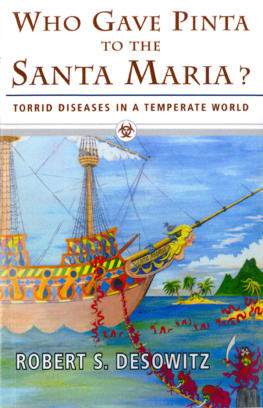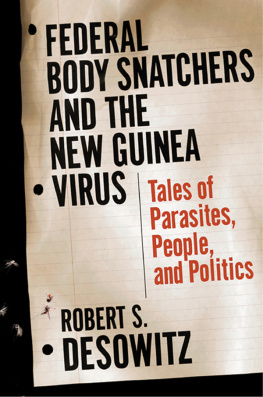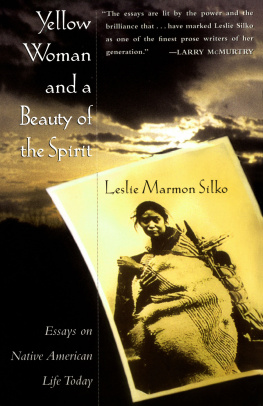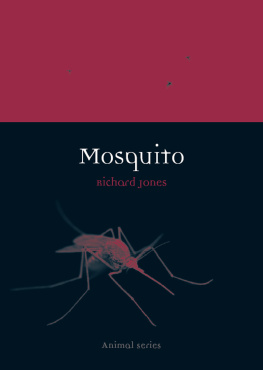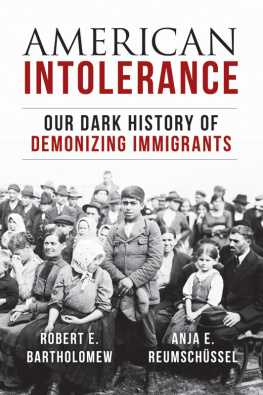
The Malaria Capers
The Thorn in the Starfish
New Guinea Tapeworms and Jewish Grandmothers
Who Gave
Pinta to the
Santa Maria?
Torrid Diseases in a
Temperate World
Robert S. Desowitz

WWNORTON & COMPANY
NEW YORK LONDON
Who Gave
Pinta to the
Santa Maria?
Copyright 1997 by Robert S. Desowitz
All rights reserved
First Edition
For information about permission to reproduce selections from this book,
write to Permissions, W. W. Norton & Company, Inc., 500 Fifth Avenue,
New York, NY 10110.
The Library of Congress has cataloged the printed edition as follows:
Desowitz, Robert S.
Who gave Pinta to the Santa Maria? : torrid diseases in a
temperate world / by Robert S. Desowitz.
p. cm.
Includes index.
ISBN: 978-0-393-33264-3
1. Tropical medicineAmerica. I. Title.
RC962.A45D47 1997
616.9883dc20 96-44741
CIP
ISBN: 978-0-393-25404-4 (e-book)
W. W. Norton & Company, Inc., 500 Fifth Avenue, New York, N.Y. 10110
www.wwnorton.com
W. W. Norton & Company Ltd., Castle House, 75/76 Wells Street, London W1T 3QT
For Carrolee
IN THE BEGINNING the intent was simple; this book would relate, concisely, how some of the classically tropical diseases came from the Old World to the New World. There would be a straight story line. But the book material took over, and the story weaves and dodges in faithful reflection of how things really are rather than how writers and their editors would like them to be. Over the aeons of human existence, infectious microbial-parasitic diseases appear, disappear, and shape the social, economic, and cultural fabric while the social, economic, and cultural fabric shapes the infectious diseases. What a mishmash! I think a wonderfully fascinating one. So I hope the reader will not only forbear but also take enjoyment as we weave and dodge through some of our medical history from 50,000 B.C. to 2500 A.D.
In writing this book I had a support group of old and new friends and colleagues, generous of their time and advice: Dr. Louis Miller, head of the Laboratory of Parasitic Diseases at the National Institute of Health, gave his customary sagacious advice and suggestions; Dr. Tom Monath of the Oravax Corporation kept me straight on yellow fever; Dr. Tom McCutcheon shared his new, exciting research findings on malaria with me and in doing so threw my nice orderly ideas on malaria in the pre-Columbian Americas into total confusion; Dr. Richard V. Lee, professor of pediatrics, obstetrics and gynecology, and geographical medicine at the State University of New York at Buffalo, School of Medicine, kept me straight on syphilis and shares a kindred sentiment on the nature of health and the value of yellow pickup trucks; and Profs. Marc Wry and Domenique LeRay of the Prince Leo-pold Institute of Tropical Medicine, Antwerp, offered their hospitality and shared their great fund of knowledge during my stay there as a Damien FoundationFulbright Research Fellow. Mrs. Nancy Miller suggested the jacket cover design. My final words of appreciation are for my wife and best friend, Carrolee.
Honolulu, Hawaii
Antwerp, Belgium
Pinehurst, North Carolina
IN 1962, when Indonesias dictator, Sukarno, was in flower, I attended a meeting of the Southeast Asian Ministers of Education Secretariat Tropical Medicine Project. The representative from Indonesia opened the session by hotly proclaiming that there was no such thing as tropical medicine; it was a colonial term of denigration (the implication being that the whites were hygienic and the natives unsanitary). The head of the project, Prof. Chamlong Harinasuta, the Thai physician and scholarly scientist, was equally adamant in his rebuttal. Everyone knew what tropical medicine was. Chamlong won the day: Tropical Medicine Project it was to remain, and still is. To suggest that tropical diseases were no more exotic than, say, a common cold or heart attack in Buffalo might well discourage the United States and other governments who were funding the project. Who was correct? Was Chamlong a pawn of the neocolonists or is there, in truth, a special segment of medical science geographically unique to the tropical regions? The answer is probably yes; both were correct in their interpretation of what constitutes a tropical disease.
Some diseases have always been confined to tropical locales beyond the temperate zones. Most, if not all, are infections caused by parasites, bacteria, or viruses. Many of these pathogens are in exquisite biological dependency to a spineless third party, such as a mosquito or a snail, for transmission from one host to another. But in truth, only a few exclusively tropical diseases come to mind. Most have ranged so widely as to be almost cosmopolitan. Malaria, that exemplar of the tropical disease? It once sickened and killed Californians, North Carolinians, Hollanders, and the English residents in the Thames estuary marshlands of London. Yellow fever? Killing epidemics raged from Boston to New Orleans between 1673 and 1905. There was even a mini-epidemic in Swansea, Wales in 1865. Cholera? There were fearful epidemics throughout pre-sewer North America. And epidemic cholera, the most feared disease of the nineteenth century, has again come to the Americas with 332,562 cases in Peru, 2,690 cases in Mexico, and 26 cases in the United States during 1991. Hookworm? It was once the great desanguinator of the rural U.S. southerner, the California miner, and the Alpine Swiss tunneler of St. Gothard. And what of the giant, elephantine, scrotum of filariasis which once afflicted the male citizen of Charleston?
Of those pathogens now confined to tropical countries most depend on their geographically limited hosts. The virus of Lassa fever, for example, normally circulates among African rodents, and from them, humans contract the infection. Lassa fever is a zoonosisan infection from animal to human. Some pathogens are geographically confined because of the idiosyncratic behavior of the human hosts. The whatever it is pathogen of kuru is or was limited to the Fore people of Papua New Guinea who ritualistically ate the brains of their enemies.
Even so, the most tropical pathogens can break out from their motherland to the cool north and south as well as elsewhere. We are not isolated or insulated from the scourging microbial and parasitic diseases of the tropics. The Lassa fever virus brought in by an African stowaway rodent might, for example, adapt to the sewer rats of New York or London. Confronted with the most frighteningly deadly viruses yet to emerge from the tropics, the Ebola and Marburg viruses of Africa, there is much anxiety in the West that the doomsday bugs can spread from their normal habitat. Certainly, the past history of tropical temperate disease exchange can give us scant comfort. Our world has never been compartmentalized.
MY GRANDPARENTS sailed to America from Austria and Galicia in the 1880s, swept up in the wave of nineteenth-century immigration. Neglectful of family history, I cant trace my origins back more than a century. Still, even that small fragment of history pleases me. We take comfort in knowing where we come from and the historical causes that ultimately brought us here. I mention this bit of autobiography because on occasion I visit my two young grandsons in Florida and grandfathers of all societies have a ritualistic obligation to (1) bring toys and (2) pass down the mysteries and genealogy of the tribe. The problem is, my grandsons have the privilege of being part American Indian, and there is still some uncertainty as to their deepest roots. There are some clues, some speculations. And thats how it should be; grandfather stories should never precisely cleave to facts.
Next page
